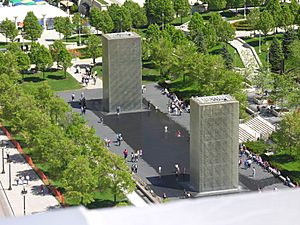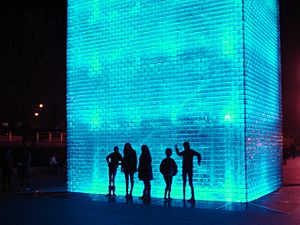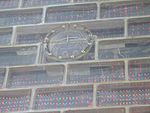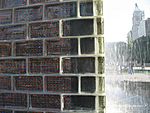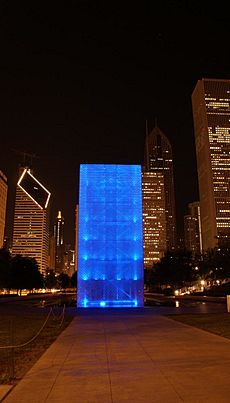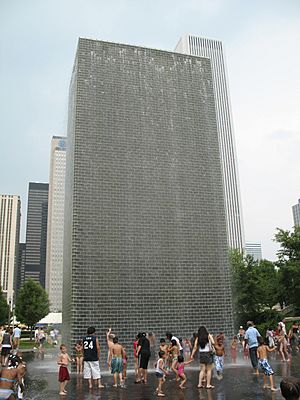Crown Fountain facts for kids
Quick facts for kids Crown Fountain |
|
|---|---|
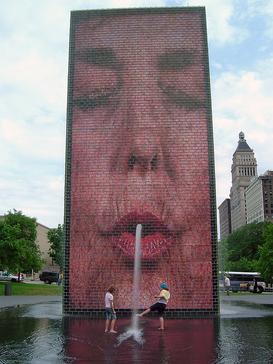
Crown Fountain spouting water on visitors
|
|
| Artist | Jaume Plensa |
| Year | 2004 |
| Type | black granite reflecting pool dual LED screen, glass brick sculptures |
| Dimensions | 15 m (50 ft) |
| Location | Millennium Park, Chicago, Illinois |
The Crown Fountain is a super cool and interactive art piece in Chicago's Millennium Park. It's like a giant video sculpture where you can play in the water! A Spanish artist named Jaume Plensa designed it, and it opened in July 2004.
This fountain has two tall towers made of glass bricks, with a shallow black granite pool in between them. The towers are 50 feet (about 15 meters) tall. They use special lights called light-emitting diodes (LEDs) to show digital videos on their inner sides. Building the Crown Fountain cost $17 million.
The water usually runs from May to October. It flows down the sides of the towers and even shoots out from a nozzle on each tower's front! People in Chicago and visitors love the fountain because it's fun and artistic. It shows off Plensa's ideas about two opposing things (dualism), light, and water. Unlike many other fountains, this one lets you actually touch and play in the water. It's also easy for everyone to enjoy, thanks to its smart design.
Even though it's popular now, the Crown Fountain was a bit controversial at first. Some people worried the towers were too tall for the park's look. After it was built, cameras were put on top, which made people upset, so they were quickly removed. But the fountain got past these early issues and became a famous part of Chicago. It's a favorite spot for photos and a great place to meet up. While some videos show nature scenes, most people love seeing the faces of local Chicago residents. It's a perfect spot to cool off and play in the summer heat!
Contents
What Inspired the Crown Fountain?
Grant Park, often called "Chicago's Front Yard," sits between Lake Michigan and the city center. Before 1997, this area was mostly old rail yards and parking lots. Then, the city decided to turn it into Millennium Park. This new park was planned in 1998 to celebrate the new millennium and feature amazing artists and designers from around the world.
The Crown Fountain is right in the middle of Chicago. It's near Michigan Avenue and the Art Institute of Chicago. If you look north from the fountain, you can see some of the tallest buildings in the United States!
Choosing the Artist
In December 1999, the Crown family decided to help pay for a water feature in Millennium Park. They were very involved in the project, even doing their own research and holding a design contest. They wanted a modern art piece and asked many artists and architects for their ideas.
Jaume Plensa studied the history of fountains and how they often looked like people. He showed the Crown family a presentation with fountains from different time periods and even computer animations of faces. Other artists had ideas too, like a low, flat fountain or a very tall one. But in January 2000, Plensa was chosen to design the fountain. His video sculpture was planned to work for thirty years!
The Artistic Idea Behind the Fountain
Before the Crown Fountain, Plensa often explored the idea of "dualism" – showing two opposite things. He also worked with light, LED technology, and video in his art. He wanted people to interact with his public art. This led him to create the Crown Fountain. His goal was to make a fun, interactive fountain for the 21st century.
Since Chicago is so close to a big lake, Plensa wanted to create a water artwork that fit the natural surroundings. Because Chicago winters are cold, he also designed the fountain to look cool even when the water isn't running. It becomes a display of lights and videos.
Plensa shows dualism in the Crown Fountain by having two faces "talk" to each other. He believes using faces helps show how diverse Chicago is, with people of all ages and backgrounds. He hopes to update the faces over time to show how the city changes. The fountain has even appeared in TV shows like Prison Break!
Plensa believes that good public art lets people interact with it. The fountain is famous for letting visitors splash and play in the water. This interaction was a bit of a surprise, even for Plensa! The city expected some interaction, but it quickly became a water park for kids. Now, when it's super hot in summer, the Crown Fountain is known as a great place for people to cool down.
Making the Videos for the Fountain
Around 75 different groups in Chicago helped find people to be filmed for the fountain. Students from the School of the Art Institute of Chicago (SAIC) filmed them using a special high-definition video camera. About 20 students worked on this project, learning a lot about public art.
Each face appears on the towers for five minutes. The videos are played at different speeds. For example, there's a part where the person's mouth puckers, which is timed perfectly with the water spouting out. This makes it look like the water is coming right from their mouth, like old gargoyle fountains! After the water spouts, the face smiles.
Out of over 1,000 people filmed, 960 videos were used. The faces are cropped so you usually don't see hair or ears. Special equipment was used to film the faces, and sometimes digital editing was needed to make sure the mouths lined up perfectly for the water effect. The videos were also adjusted for brightness and color so they look good even in sunlight.
How the Fountain Was Built
The Crown family gave $10 million towards the $17 million cost of building the fountain. Other families also helped, and all the money came from private donations.
Two architecture firms said no to building Plensa's design, but Krueck and Sexton Architects said yes. This was a new kind of project for them, as they usually designed homes and offices. The artist, architects, and other experts worked closely together to make the fountain happen.
The fountain's black granite pool is 48 feet (14.6 meters) wide and 232 feet (70.7 meters) long, with water only about a quarter-inch (6 mm) deep. The two glass brick towers are 50 feet (15 meters) tall, 23 feet (7 meters) wide, and 16 feet (4.9 meters) deep. The architects designed a special stainless steel frame to hold the 50-foot-tall glass walls and withstand strong winds.
A company called L. E. Smith Glass Company made 22,500 special glass blocks for the towers. They used a unique process to make these large blocks from molten glass. The glass is white, not the usual green, which makes the images clearer but also shows dirt more easily. Each block is 5 by 10 by 2 inches (127 by 254 by 51 mm).
The glass blocks are held in place by a special metal grid system. This grid is almost invisible because of how the glass bends light and how thin the metal is.
The fountain uses 11,000 gallons (41,639 liters) of water per hour, and 97% of it is recycled! Getting the water to spout from the faces was tricky. They had to recess one LED tile in each tower to fit a clear tube for the water nozzle. The water regularly flows down the towers and also spouts from the nozzle. Special fittings were designed to guide the water and control its flow, making it safe for people playing in it.
The fountain uses over a million LEDs! The inside surface of each tower has 147 smaller screens with a total of 264,480 LED points. Each point has five tiny LEDs (two red, one blue, two green). The designers had to figure out how to support all these lights, keep them cool, and make sure the display looked good. Fans cool the air inside the chimney-like towers. The LEDs are placed about 2 inches (51 mm) behind the glass for the best view.
LEDs were chosen because they last a long time and don't need much maintenance. They don't have filaments that burn out, so they don't get too hot. Fins were added to the screens to block direct sunlight. The lights are designed to change with the time of day, weather, and season, and to last for a very long time.
The pool floor uses heavy pavers that weigh 250 pounds (113 kg) each. These pavers are carefully leveled using special pedestals. The fountain has many sensors to control the water flow and level.
Building the fountain was also tricky because there's an underground parking garage right beneath it! The design allows for easy access inside the towers for maintenance. Individual glass blocks can be removed for cleaning or repair without stopping the display. The filtered air inside the towers helps keep them clean. The Crown Fountain was designed to be easily used by everyone, no matter their physical abilities.
How the Fountain Works
Opening Day
Testing of the video sculpture began on May 18, 2004, without the water running. At first, Plensa wanted each face to appear for 13 minutes, but professors convinced him to use five-minute videos instead.
The Crown Fountain officially opened to the public from July 16–18, 2004, as part of Millennium Park's grand opening. At that time, only 300 of the videos were ready. The fountain was officially dedicated on July 24, 2004, at a special event that raised money for the park.
Daily Operation
The control center for the fountain is in a room under one of the towers. This room has computers that store all the face videos and control the images, water flow, and lights. The computer programs automatically decide when a face will pucker and when to turn the water on or off, depending on the weather.
A special controller picks the order of the faces randomly. At night, spotlights light up the cascading water. The city pays about $100,000 each year for the space the control room takes up in the underground parking garage. Maintaining the fountain costs about $400,000 each year. The water usually runs from mid-spring to mid-fall, but the images stay on the screens all year.
The Video Sculpture
The front of each tower constantly shows lights and electronic images. Sometimes you'll see landscapes like waterfalls, but the most exciting part is seeing the faces of Chicago residents. About 1,000 different faces are shown in a random order. Each face stays on for five minutes, with a short break of darkness between videos. This means no more than 12 faces appear per hour in the summer. In winter, the videos are shorter (four minutes) because the water isn't spouting. There's also a three-minute water scene every half-hour and a 30-second fade to black every 15 minutes.
The water that seems to shoot from the faces comes from a 6-inch (152 mm) nozzle in the center of each tower's inner face, about 12 feet (3.7 meters) above the pool. The images are shown every day, all year, but the water only runs from May 1 to about October 31, if the weather is good.
Each tower is lit from inside on three sides by about 70 color-changing LED lights. The fourth side has the video screens. At night, some videos are replaced by nature scenes or solid colors. The other three sides of the fountain also display changing colors at night. The Crown Fountain is a constantly changing artwork with different water and light effects.
The Water Fountain
The Crown Fountain has special slits and grates to drain the 11,520 gallons (43,600 liters) of water per minute. When the videos aren't on the front of the towers, water cascades down all sides. The water is filtered, pumped, and reused. Pumps under each tower draw water from a reservoir beneath the pool. There are 12 mechanical pumps controlled from a room in the underground parking garage. The water in the reflecting pool is only about 0.33 inches (8.4 mm) deep.
Future Updates
In 2014, the computer systems that run the fountain were updated. There were also plans to change some of the lights and update the video screens. Jaume Plensa, the artist, believes that future generations might want to update the faces used in the videos to show how humanity changes over time. In 2014, it was expected that another 1,000 faces would be added by 2016.
See also
 In Spanish: Fuente Crown para niños
In Spanish: Fuente Crown para niños


